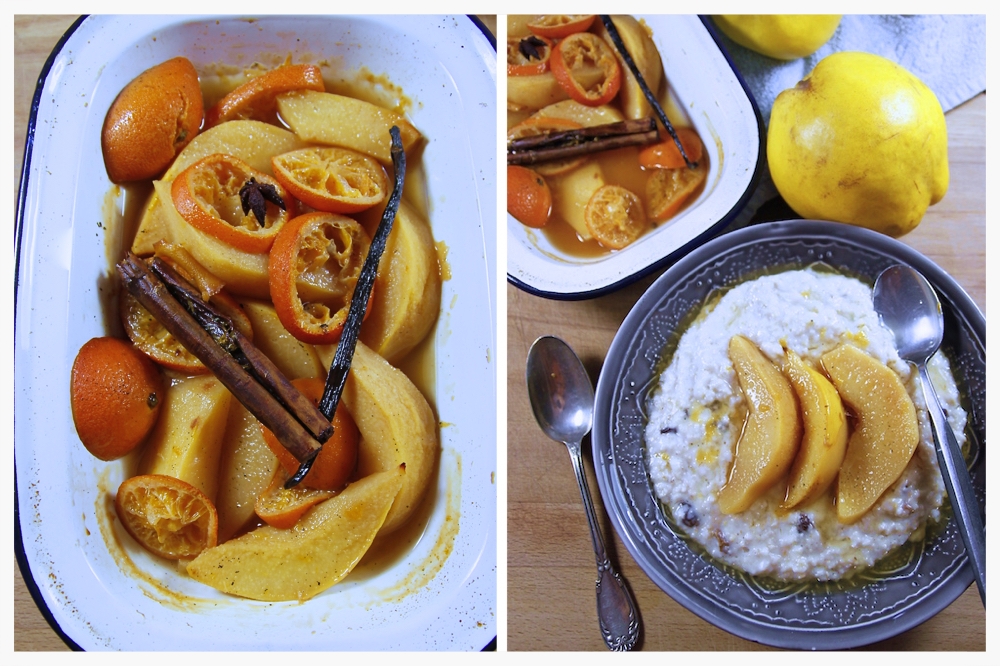I was going to start this post by declaring that I am a happier person when both figs and quinces can be found in the market. However, I realise that is not strictly true. I am, in fact, a more anxious person - anxious that their short season will be over before I can exploit them to their full potential. I've already devoted at least two whole posts to the magnificence of such fruits - they seem exotic and otherworldly, somehow, yet both grow quite happily on our own English soil - so will spare you the raptures. Instead, I will write about a meal that did actually make me a happier person, comprising as it did both figs and quinces and ticking another of the "things I want to try with figs and quinces" list.

I set out for the market intending to purchase a nice fat chicken with which to make a fig and walnut tagine. Unfortunately, lack of said chicken meant I had to compromise. I would go as far as to say that this was in fact infinitely better than compromise - it was improvement. I ended up with a shoulder of lamb on the bone, a cut I don't normally use, preferring to use diced shoulder in a tagine or casserole. However, I figured I could still incorporate elements of the originally intended tagine: I rubbed the lamb with saffron, cinnamon and ginger mixed with olive oil. It went in a hot (240C) oven for 15 minutes and then I turned it down to 160C and let it cook away for a couple of hours. How long exactly I am not sure - as long as it took for me to read a few pages of Gifford's Dialogue Concerning Witches and decide that it was too late in the day to be reading annoying early modern script where all the S's look like Fs.

Next, some couscous stirred up with the seeds of half a pomegranate. The pomegranates I found at the market today are truly fine specimens, infinitely better than the watery, pale pink and slightly bitter versions I've been putting up with so far this autumn. The seeds of these have a real sweet sourness to them and are a beautiful vibrant colour. I also put some crumbled walnuts into the couscous. For the last five minutes of cooking, I put some halved figs into the roasting tray with the lamb and drizzled over some honey. The shredded lamb meat went in with the couscous with the figs on the side. They had turned molten and scarlet, almost the colour of the pomegranate seeds, and went beautifully with the lamb. I'd forgotten how much I love lamb shoulder cooked on the bone; the meat is sublime and so versatile.

For dessert. something from the new Nigel Slater book, Tender II. This book is enough to bring me to the verge of tears because I don't have Mr Slater's metabolism. There are enough recipes for pies, crumbles and tarts in there to guarantee I'd never see my hipbones again. How he manages it, I really don't know, especially because he recommends serving everything with "cream: thick, yellow, unpasteurised". The photo for the recipe of "soft quinces under a crisp crust" simply looked too good to resist.

Said crisp crust is a mixture of brown sugar, flour, butter, brown breadcrumbs and ground almonds. It is a bit like the pear betty topping I made a few weeks ago; much crunchier and more buttery than a traditional crumble topping, I think it will be my new blanket with which to wrap up warm fruits. The quinces are sauteed into soft, golden tenderness with butter, sugar and lemon juice and then baked under the crumble for half an hour or so. I put a pear in with the quinces just for a difference in flavour and texture. They go rather well together, which makes sense, seeing as they are quite similar in shape.
I must say, however, that the task of peeling, halving, quartering, coring and slicing four large quinces is enough to mean I probably don't need to do any arm-based weightlifting at the gym tomorrow. Especially with a blunt knife. I can almost see why so many people overlook these fine fruits: preparation is a faff and a half.
But so, so worth it, however, when you bite into that mouthful of perfumed, buttery, juicy fruit and its crunchy topping, with hints of treacle from the dark brown sugar used and little nuggets of toasted breadcrumb. I might have to make this one again; it is beautiful. As are its colours, which I think look like autumn in a bowl.
So there we have it. Two of my favourite things, and some excellent other things with which to partner them to maximise their full potential. Delicious.
































































